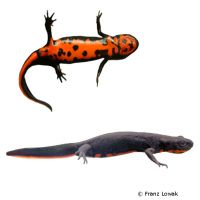Oriental Fired-bellied Newt (Cynops orientalis)
| Oriental Fired-bellied Newt Cynops orientalis | |
|---|---|
| Name | Oriental Fired-bellied Newt |
| Name Lat. | Cynops orientalis |
| Synonym | Hypselotriton orientalis |
| Family | True Salamanders |
| Family lat. | Salamandridae |
| Order | Salamanders |
| Order lat. | Caudata |
| Origin | East Asia |
| Habitat | Wetlands |
| Diet | Carnivore |
| Humidity | 70-90 % |
| Behavior | Semi-aggressive |
| Keeping | Individual, group |
| Care Level | Moderate |
| Breeding | Moderately difficult |
| Housing | Aquaterrarium |
| Life Span | 15-20 years |
| Protection | No |
| Metric Units | |
| Size | 9 cm |
| Temperature | 16-20 °C |
| Housing Size | 60 x 40 x 40 cm |
| US Units | |
| Size | 3.5" |
| Temperature | 61-68 °F |
| Housing Size | 25" x 15" x 15" |
Distribution and habitat
The distribution range of the diurnal Chinese Fire-bellied Newt extends from central to southern China. There they live in vegetation-rich, slow-flowing and stagnant waters, such as streams, ponds, pools, swamps and rice fields up to 1,000 m above sea level.
Maintenance
The specifications are minimum dimensions for the aquaterrarium, according to the size and number of animals:
| 1-2 animals | ground area in m²: GL x 0,01 |
The total length (GL) is measured at the largest animal. For each additional animal the base area must be increased by 25 %. An aquaterrarium of L 60 x W 40 x H 40 cm is recommended, which should be placed in a quiet and vibration-free place.
You need an aquaterrarium structured with roots, flat stones and cork tubes (hiding places and visual protection), a moisture retaining substrate, e.g. of sand-peat mixture with coconut fibers, foliage and sphagnum moss as well as a water part of approx. 30 % of the bottom area with aquatic plants roots and stones, which rises flat to the land part. A filter to maintain water quality is recommended. To allow burrowing, the substrate should be about 20 cm deep in places and about half should be kept moist at all times. Ficus pumila and Scindapsus, for example, are suitable for planting. Once a day, preferably in the evening, the inside of the terrarium should be finely sprayed with water (humidity), but a rain or mist system is better
| Temp. day: 16-20 °C | Temp. night: 14-18 °C | Humidity: 70-90 |
The lighting duration must be 10-14 hours depending on the season. Daylight fluorescent tubes with low UV content are very suitable.
Diet
The food supply consists of live food, such as daphnines, mosquito larvae, artemia, mysis, earthworms, slugs, maggots, caterpillars, etc., supplemented with frozen food mixtures, vitamin and mineral supplements, and a high-quality dry food (pellets, granules) for insectivorous reptiles. Adult animals should be fed every 2-3 days, young animals daily. Unaccepted food must be sucked out after 2-3 hours. A regular and varied diet promotes health and prevents deficiency symptoms.
Reproduction and breeding
Mating and egg laying takes place in the water after dormancy. The female lays up to 200 eggs individually on water plants. The larvae hatch after about 3 weeks and can be fed e.g. with cyclops, daphnia, artemia and mosquito larvae. After 80-120 days the transformation (metamorphosis) is completed and they leave the water. This is followed by a purely terrestrial phase of 6 to 12 months. Their life expectancy can be over 15 years.
Important
They are well tolerated among themselves. A prerequisite for breeding is a hibernation period of 2-3 months. For this, the lighting duration must be shortened by 4-6 hours and the temperature lowered to 5-10 °C, depending on the origin.
They can climb vertically on glass panes, accordingly the terrarium must be well covered.
Before buying should be prepared aquaterrarium that meets the specific needs of the species. Necessary is good ventilation without drafts, as well as equipment for measuring temperature and humidity. The lighting must correspond to the species-specific day-night rhythm and must be installed in such a way that the animals cannot injure themselves. The aquaterrarium should be closed in such a way that neither unauthorized persons can open it nor the animals can escape. Special attention must be paid to thorough hygiene and impurities must be removed regularly.
Further literature can be found in your pet store
References
Text: Serena Werle; Image: Franz Lowak
Source: ENGELMANN (2006): Zootierhaltung - Tiere in menschlicher Obhut: Reptilien und Amphibien, Harri Deutsch Verlag; VDA & DGHT (2006): Allgemeine Haltungsrichtlinien für Molche und Salamander
- Gemäß § 21 Abs. 5 Tierschutzgesetz idgF
